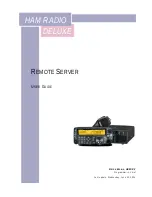
107
D14049.07
March 2010
Grey Headline
(continued)
TANDBERG
VIDEO COMMUNICATION SERVER
ADMINISTRATOR GUIDE
Introduction
Overview and
status
System
configuration
VCS
configuration
Zones and
neighbors
Clustering and
peers
Call
processing
Bandwidth
control
Firewall
traversal
Appendices
Applications
Maintenance
URI dialing
URI dialing via DNS for outgoing calls
URI dialing process
When a user places a call using URI dialing, they will typically dial
an address in the form
from their endpoint.
Below is the process that is followed when a URI address is
dialed from an endpoint registered with your VCS, or received as
a query from a neighbor system:
1. The VCS checks its
search rules
to see if any of them are
configured with a
Mode
of either:
•
Any Alias
, or
•
Alias Pattern Match
with a pattern that matches the URI
address
2. The associated target zones are queried, in rule priority order,
for the URI.
•
If one of the target zones is a DNS zone, the VCS attempts
to locate the endpoint through a DNS lookup. It does this
by querying the DNS server configured on the VCS for the
location of the domain as per the
URI resolution process
via DNS
. If the domain part of the URI address is resolved
successfully the request is forwarded to those addresses.
•
If one of the target zones is a neighbor, traversal client or
traversal server zones, those zones are queried for the URI.
If that system supports URI dialing via DNS, it may route the
call itself.
Adding and configuring DNS zones
To enable URI dialing via DNS, you must configure at least one
DNS zone. To do this:
1. Go to the
Zones
page (
VCS configuration > Zones
).
2. Click
New
. You are taken to the
Create zone
page.
3. Enter a
Name
for the zone and select a
Type
of
DNS
.
4. Configure the DNS zone settings as described in the following
sections.
5. Click
Create zone
.
To create a new DNS zone using the CLI:
•
xCommand ZoneAdd
Hop count
When dialing by URI via DNS, the hop count used is that
configured for the DNS zone associated with the search rule that
matches the URI address (if this is lower than the hop count
currently assigned to the call).
If URI address isn't matched to a DNS zone, the query may be
forwarded to a neighbor. In this case, the hop count used will be
that configured for the neighbor zone (if this is lower than the hop
count currently assigned to the call).
H.323 and SIP modes
The H.323 and SIP sections allow you to filter calls to systems
and endpoints located via this zone, based on whether the call is
located using SIP or H.323 SRV lookups.
Include address record
This setting determines whether, if no NAPTR (SIP) or SRV (SIP
and H.323) records have been found for the dialed alias via this
zone, the VCS will then query for A and AAAA DNS records before
moving on to query lower priority zones.
We recommend that this setting is left as the default
Off
,
meaning that the VCS will not query for A and AAAA records, and
instead will continue with the search, querying the remaining
lower priority zones. This is because, unlike for NAPTR and SRV
records, there is no guarantee that the A/AAAA records will point
to a system capable of processing the relevant SIP or H.323
messages (LRQs, Setups, etc.) - the system may instead be a
web server that processes http messages, or a mail server that
processes mail messages. If this setting is
On
, when a system
is found using A/AAAA lookup, the VCS will send the signaling to
that destination and will not continue the search process. If the
system does not support SIP or H.323, the call will fail.
Zone profile
For most deployments, this option should be left as
Default
.
Configuring search rules for DNS zones
If you want your local VCS to use DNS to locate endpoints
outside your network, you should create a DNS zone and set up
associated search rules that use the
Pattern string
and
Pattern
type
fields to define the aliases that will trigger a DNS query.
For example, rules with:
•
a
Pattern string
of
.*@.*
and a
Pattern type
of
Regex
will
query DNS for all aliases in the form of typical URI addresses
•
a
Pattern string
of
(?!.*@example.com$).*
and a
Pattern
type
of
Regex
will query DNS for all aliases in the form of
typical URI addresses except those for the domain
example.
com
To set up further filters, configure extra search rules that target
the same DNS zone. You do not need to create new DNS zones
for each rule unless you want to filter based on the protocol (SIP
or H.323) or use different hop counts.
TANDBERG does not recommend configuring search rules
with a
Mode
of
Any Alias
for DNS zones. This will result in
DNS always being queried for all aliases, including those
that may be locally registered and those that are not in the form
of URI addresses.
Configuring DNS servers
To configure the DNS servers used by the VCS for DNS queries:
•
System configuration > DNS
. You are taken to the
DNS
page.
•
xConfiguration IP DNS Server
Address 1 to
Address 5
Enter the IP addresses of up to 5 DNS servers that the VCS will
query when attempting to locate a domain. These fields must use
an IP address, not a FQDN.
The DNS servers configured here are used as part of both
the ENUM dialing and URI dialing via DNS processes.
If you do not configure any DNS servers, calls made using
URI dialing will still be placed if the destination endpoint is locally
registered or registered to a neighbor system, because locating
these URIs does not require the use of DNS.
















































